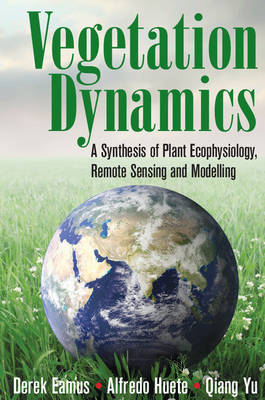
Vegetation Dynamics
Cambridge University Press (Verlag)
978-1-107-05420-2 (ISBN)
Understanding ecosystem structure and function requires familiarity with the techniques, knowledge and concepts of the three disciplines of plant physiology, remote sensing and modelling. This is the first textbook to provide the fundamentals of these three domains in a single volume. It then applies cross-disciplinary insights to multiple case studies in vegetation and landscape science. A key feature of these case studies is an examination of relationships among climate, vegetation structure and vegetation function, to address fundamental research questions. This book is for advanced students and researchers who need to understand and apply knowledge from the disciplines of plant physiology, remote sensing and modelling. It allows readers to integrate and synthesise knowledge to produce a holistic understanding of the structure, function and behaviour of forests, woodlands and grasslands.
Professor Derek Eamus is a professor in the School of Life Sciences, University of Technology, Sydney. He is an internationally recognised plant ecophysiologist and ecohydrologist. He specialises in measuring plant water relations, stomatal behaviour, the carbon and water balances of native woodlands and forests and forging of cross-disciplinary links between our understanding of processes at cellular, whole plant and canopy scales. He has worked extensively in north Australian mesic savannas, arid-zone central Australia and temperate mesic forests, including a range of groundwater dependent ecosystems. He has published more than 185 research publications in diverse journals, including Nature, Nature Climate Change, Remote Sensing of Environment, the Journal of Hydrology, Tree Physiology, Global Change Biology and Agricultural and Forest Meteorology. In 2010 he was awarded the inaugural Chancellor's Medal for Research Leadership and simultaneously, the inaugural Vice-Chancellor's Medal for Research Excellence, from the University of Technology, Sydney. He is the author of Ecohydrology: Water and Resource Management (2006), which provided the first integrative text on hydrology, ecophysiology and ecology of Australian landscapes. Professor Alfredo Huete is a professor in the School of Life Sciences, University of Technology, Sydney. He is a world renowned geospatial ecologist who uses advanced remote sensing tools to assess broad scale ecosystem functioning, vegetation phenology and health. He uses satellite and field observations to assess land surface interactions and ecosystem resilience with climate, land use activities and major disturbance and extreme events. Professor Huete has twenty-five years experience in vegetation remote sensing for NASA mission teams. He is a founding and continuing member of the NASA-EOS MODIS Science Team. In recognition of his pioneering work in the design of vegetation satellite products used by the remote sensing community to assess vegetation biophysical states and processes of global ecosystems, he earned a NASA Service Achievement Award for NASA MODIS Product Development and a NASA Group Achievement Award for the Suomi NPP Mission Development Team. The satellite products he developed are among the most widely used by the scientific community and natural resource and agriculture stakeholders. He has published several high impact papers in journals such as Nature, Science, and the Proceedings of the National Academy of Sciences. Professor Qiang Yu was appointed Professor of Ecological Modelling at the University of Technology, Sydney in 2008. He joined UTS from the Chinese Academy of Science, where he had been appointed professor in the prestigious 'Hundred Talents Program' in 1997. He authored the book Ecological Processes and Modelling in Farmland in 2007. His principal research interests are ecophysiological modelling, land surface processes modelling, crop growth modelling, spatial analysis and water resources management, and he also has expertise in ecological and micrometeorological measurement techniques. Professor Yu has evaluated many ecosystem models using data from the Chinese Ecological Research Network, including WOFOST, RZWQM, APSIM, SHAW and CABLE. These models have been applied to elucidate climate change/variability impacts, plant production and water use and management. Professor Yu is the author of the China Agricultural Ecosystem Model (ChinaAgrosys). In 2005 he was awarded the prestigious Sir Frederick McMaster Fellowship by the Commonwealth Scientific and Industrial Research Organisation (CSIRO).
Preface; Part I. Plant Ecophysiology: 1. An introduction to biogeography: broad-scale relationships amongst climate, vegetation distribution and vegetation attributes; 2. An introduction to plant structure and ecophysiology; 3. Water relations, hydraulic architecture and transpiration by plants; Part II. Remote Sensing: 4. Remote sensing: introduction and overview; 5. Fundamentals and physical principles of remote sensing; 6. Satellite sensors and platforms; 7. Remote sensing of landscape biophysical properties; Part III. Modelling: 8. An introduction to modelling in plant ecophysiology; 9. Modelling radiation exchange of leaves and canopies; 10. Modelling leaf and canopy photosynthesis; 11. Modelling stomatal conductance; 12. Modelling leaf and canopy water fluxes and the SPAC; 13. Coupling models of photosynthesis, transpiration, stomatal conductance and environmental controls of fluxes; Part IV. Case Studies: 14. Boreal forests; 15. Arid and semi-arid grasslands; 16. Case study: savannas; 17. Seasonal behaviour of vegetation of the Amazon Basin; 18. Case study: tropical montane forests; 19. Groundwater dependent ecosystems; 20. Global change drought and forest mortality; Index.
| Erscheint lt. Verlag | 31.3.2016 |
|---|---|
| Zusatzinfo | 24 Tables, black and white; 204 Line drawings, unspecified; 139 Line drawings, color |
| Verlagsort | Cambridge |
| Sprache | englisch |
| Maße | 184 x 260 mm |
| Gewicht | 1260 g |
| Themenwelt | Naturwissenschaften ► Biologie ► Botanik |
| Naturwissenschaften ► Geowissenschaften ► Geografie / Kartografie | |
| Technik ► Umwelttechnik / Biotechnologie | |
| ISBN-10 | 1-107-05420-6 / 1107054206 |
| ISBN-13 | 978-1-107-05420-2 / 9781107054202 |
| Zustand | Neuware |
| Haben Sie eine Frage zum Produkt? |
aus dem Bereich


